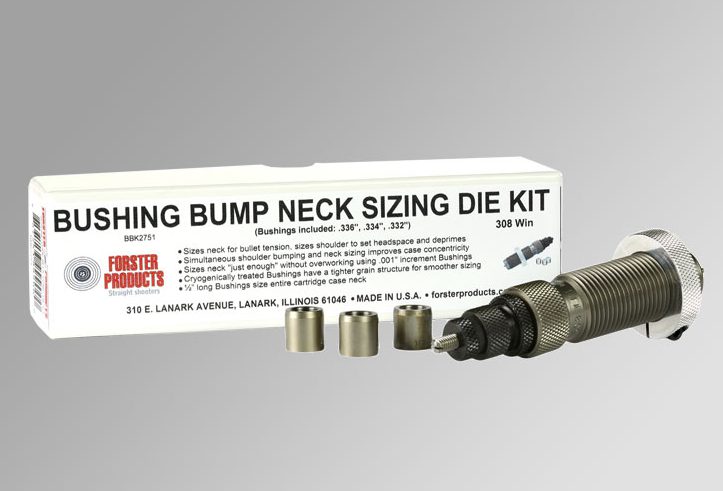Neck-only resizing is an option for the bolt-action owner. Here are some ideas on why it works, and when it works best… Keep reading!

Glen Zediker
Cartridge case re-sizing is one of those topics that draws lines and forms camps. I am a big believer in full-length sizing, for any action type or use, and just saying that immediately draws argument.
Before getting into the “whens” and “whys” respecting full-length or neck-only sizing, here’s one that I think is an absolute: cases for reuse in a (any) semi-automatic should be full-length sized; neck-only sizing is only for bolt-actions. Having established that, all this next really only relates to what’s possible with a bolt-gun.
Backing up a bit: a “full-length” sizing die is one that returns the cartridge case body (and shoulder, if adjusted to do so) to near-to-new dimensions. A “neck-only” sizing die doesn’t touch the case body (and may or may not be able to touch the case shoulder). A full-length sizer also sizes the case neck, and, normally, the entire height of the case neck cylinder. A neck-only die can be adjusted to contact the height of the neck cylinder in various amounts.

The idea behind a neck-only die is to preserve fired case dimensions: make the case a closer mirror of rifle chamber dimensions. One advantage of neck-only sizing comes to those who expect, or need, to get a good many loadings from their cases, since this approach minimizes case stretching on subsequent firings.
However, the primary flag waved by neck-only fans says that it produces the best accuracy, and that full-length sizing is a compromise, favoring function over accuracy. I do and don’t agree, and the rest of this article I hope will clarify what I just said…
The reason I do and don’t agree is that I know folks who cannot get a good group unless they neck-only size, and I know other folks, and I’m one of them, who get very small groups following what many would say is “over-sizing” their cases.

I believe that the main influence in realizing the virtues of neck-only sizing has a whopping lot to do with the rifle chamber. Specifically, factory-made, off-the-shelf bolt-actions tend to have relatively more generous chamber dimensions, as will many older surplus-sourced rifles. “More generous” is in reference to the tolerances established for the SAAMI blueprint for the cartridge. This is (wisely) done to help ensure that any and all factory ammo will chamber and fire, and also to help ensure general and all-around feeding reliability. Additionally, it’s common to find some (slightly) oval chambers in factory guns; that has a lot to do with the freshness of the tooling when that chamber was cut. It’s even more common to find them that are off-center.
Purpose-built bolt-action competition rifles, such as those constructed for use in NRA High Power Rifle competition, are custom-chambered* and, while few will use what we might call a “tight” chamber, it’s not likely to encounter one on the larger end of acceptable dimensions.
*”Custom,” here, doesn’t mean they are each unique, it just means that they are done by hand employing a precision-made reamer and therefore are what they ought to be, or we sure hope so. And they don’t tend to be overly generous in (any) dimensions.

So, in the circumstance where we have a chamber that’s a tad amount big and a cartridge case that’s been manufactured to (usually) the smaller end of SAAMI-set standards, that case will endure more expansion, in all directions, than if it had been in a tighter chamber. Sizing only the case neck to accept and retain another bullet, as said, reduces the subsequent expansion that will occur the next firing, but also, and this is likely if there is an accuracy improvement, the otherwise un-sized case might then be sitting more centered in the chamber. And one reason for that is, if the rifle is equipped with a plunger-style ejector (Remington 700 style) that will bear against one edge of the head of the chambered round, pushing the cartridge off-center, askew. (This ultimately creates another undesirable condition, a warp in the case, and we’ll talk about that another time.)
So, a little bigger case returning to a little bigger chamber likely has a little better chance of getting centered, and I truly believe that is why neck-only sizing can be a help to accuracy for a bolt-action. However! A dimensionally-correct case returning to a dimensionally-correct chamber will perform just as well on target. Full-length sizing a case for reuse in a rifle with what I call a “standard” chamber (which is really running a little closer to the minimums established by SAAMI) also makes for good groups. We prove that every High Power Rifle tournament.
Advice: If you notice your bolt-action doesn’t shoot too well with factory loads, neck-only sizing should pay off and is well worth a try. Do, however, make sure to gauge the cases as is often discussed in Reloaders Corner, and, specifically, cartridge case headspace. If the bolt isn’t closing easily, that’s liable to be the culprit right there: shoulder has gotten too tall.
If you’re running a factory bolt-action, by all means try neck-only sizing. If you want to compare results to full-length sizing, just make sure you’re doing that operation right.

Check HERE and HERE to get started…
The information in this article is from Glen’s newest book, Top-Grade Ammo, available HERE at Midsouth. Also check HERE for more information about this and other publications from Zediker Publishing.








